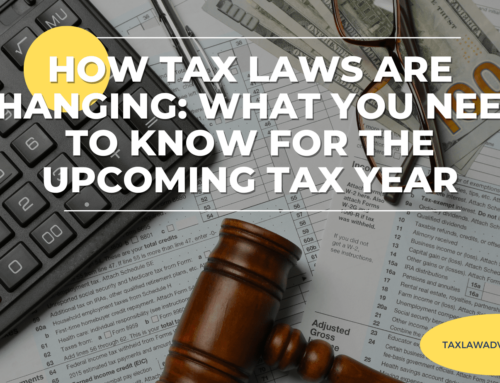Owing taxes to the IRS can be stressful, but the agency offers payment plans to help taxpayers manage their financial obligations over time. Understanding how IRS payment plans work and how to apply for one is critical for reducing stress, avoiding penalties, and staying compliant. At Tax Law Advocates, we specialize in helping taxpayers navigate IRS payment plans and other tax relief options. Contact us today at 855-612-7777 or visit our website for expert assistance.
What Is an IRS Payment Plan?
An IRS payment plan, also known as an installment agreement, allows taxpayers to pay off their tax debt over time rather than all at once. These plans are ideal for individuals and businesses who cannot pay their full tax balance immediately but can commit to regular payments.
Why Consider a Payment Plan?
– Avoid Collection Actions: By entering into a payment plan, taxpayers can prevent the IRS from levying assets or placing liens.
– Manageable Payments: Payment plans allow taxpayers to spread out their tax debt into smaller, more manageable amounts.
– Suspension of Collection Period: Once a payment plan is requested, the IRS typically pauses collection actions until the agreement is reviewed and finalized.
Types of IRS Payment Plans
The IRS offers two main types of payment plans: short-term and long-term. Your eligibility and tax debt amount will determine which option is best for you.
Short-Term Payment Plan
– Duration: Pay the amount owed within 180 days or less.
– Eligibility: Individuals with less than $100,000 in combined tax, penalties, and interest.
– Cost: No setup fee, but penalties and interest continue to accrue until the balance is fully paid.
– Payment Methods:
– Direct Pay from a checking or savings account.
– Electronic Federal Tax Payment System (EFTPS).
– Check, money order, or credit/debit card (fees apply for card payments).
Long-Term Payment Plan (Installment Agreement)
– Duration: Pay the amount owed in monthly installments.
– Eligibility:
– Individuals who owe $50,000 or less in combined tax, penalties, and interest.
– Businesses that owe $25,000 or less in combined tax, penalties, and interest.
– Cost:
– Online application: $22 setup fee for Direct Debit Installment Agreements (DDIA).
– Phone, mail, or in-person application: $107 setup fee.
– Low-income taxpayers: Fee waived or reimbursed under certain conditions.
– Payment Methods:
– Direct Debit (automatic monthly payments).
– Direct Pay from a checking or savings account.
– EFTPS or by check, money order, or credit/debit card.
Steps to Apply for an IRS Payment Plan
Applying for a payment plan can be done online, by phone, or by mail. Here’s how to get started:
Step 1: Determine Your Eligibility
– For individuals:
– Long-term plan: Owe $50,000 or less and have filed all required returns.
– Short-term plan: Owe less than $100,000.
– For businesses:
– Long-term plan: Owe $25,000 or less and have filed all required returns.
– Sole proprietors or independent contractors should apply as individuals.
Step 2: Gather Required Information
You’ll need:
– Details of your tax debt, including balances and penalties.
– Financial documentation, such as income statements and bank account information.
– Tax returns for the years in question.
Step 3: Submit Your Application
– Online: Use the IRS Online Payment Agreement tool for quick processing. This option is generally faster and has lower setup fees.
– By Mail: Complete and submit Form 9465, Installment Agreement Request.
– By Phone: Call the IRS to discuss your eligibility and request an installment agreement.
Step 4: Choose a Payment Method
Select a payment method that works for you, such as Direct Debit, EFTPS, or check. Direct Debit Installment Agreements (DDIA) are often preferred because they reduce the likelihood of missed payments and can result in waived setup fees for low-income taxpayers.
What Happens After You Apply?
Once your application is submitted:
– Processing Time: The IRS reviews your application and determines whether to approve your request.
– Temporary Suspension of Collection Actions: While your application is pending, the IRS generally halts collection actions, such as levies or garnishments.
– Approval Notification: If approved, the IRS will send you the terms of your agreement, including payment amounts and due dates.
– Rejection or Default: If your application is rejected or you default on payments, you may appeal the decision or renegotiate terms.
Costs and Fees
The cost of an IRS payment plan depends on the type of plan, your payment method, and whether you qualify for low-income status:
– Short-term plan: No setup fee but includes interest and penalties.
– Long-term plan: Setup fees range from $22 (online) to $107 (phone/mail), with reduced or waived fees for low-income taxpayers.
– Credit card payments: Additional fees apply.
Benefits for Low-Income Taxpayers
Low-income taxpayers may qualify for:
– Waived setup fees if using Direct Debit.
– Reimbursement of setup fees upon successful completion of the agreement if Direct Debit isn’t possible.
To apply for reduced fees, submit Form 13844: Application for Reduced User Fee for Installment Agreements within 30 days of receiving your acceptance letter.
Why Work with Tax Law Advocates?
Navigating IRS payment plans can be overwhelming, especially if your tax situation is complex. At Tax Law Advocates, we offer:
– Expert Guidance: Our team of enrolled agents, tax attorneys, and accountants can help you determine the best payment plan for your situation.
– Application Assistance: We’ll ensure your application is complete, accurate, and submitted promptly.
– Ongoing Support: From negotiating with the IRS to monitoring your agreement, we’re here to support you every step of the way.
If you’re struggling to pay your tax debt, don’t wait—contact Tax Law Advocates today. Our experienced team can help you set up an IRS payment plan and avoid unnecessary stress. Call us at 855-612-7777 or visit our website to schedule your consultation and take the first step toward resolving your tax debt. Let us help you regain control of your financial future.






